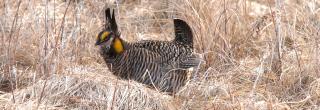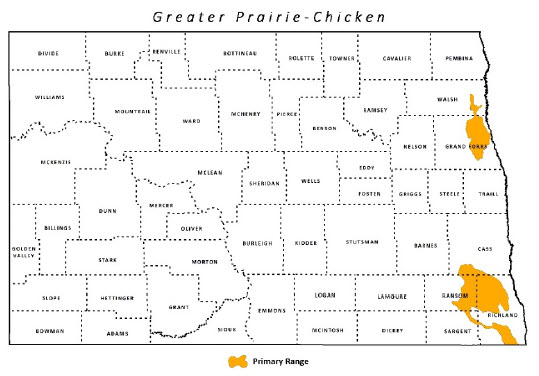

Greater Prairie Chicken
| Scientific Name | Tympanuchus cupido |
|---|---|
| General Description | L 17”, WS 28”, 2.0 lb. A short, rounded tail and completely barred body. Males have long tufts of feathers and orange air sacs on the sides of the neck. |
| Status | Year-round resident. Peak breeding season late April to early July. |
| Abundance | Uncommon. |
| Primary Habitat | Relatively undisturbed, native tallgrass prairie in association with cropland. |
| Federal Status | None. |
| Reason for Designation | Prairie chicken presence in North Dakota prior to European settlement is unclear. Following the settler movement into North Dakota, populations were documented to have increased from 1880 to 1930, but current populations are unstable. Partners in Flight (PIF) identifies the Greater Prairie-Chicken as a Regional Concern Species, U.S.-Canada Concern Species, and a Tri-national Concern Species. |
Locations and Conditions of Key Habitat
Preferred Habitat
Initially the Greater Prairie-Chicken was dependent upon tallgrass prairie oak woodland in central North America. As the birds migrated into North Dakota, tallgrass prairie interspersed with cropland became the preferred habitat. Now the presence of woody vegetation may actually reduce nest success. The amount of grassland and wetland in the landscape may positively influence prairie chickens while forest cover and distance from nearest lek are negative influences. Leks are located in areas of bare ground or short cover. Females nest reasonably close to the lek site, 2-5 km, and in relatively dense vegetation. Broods use habitat >25 cm tall, particularly lowlands or areas that contain sedges and usually are wet in the spring. Winter roosting habitat occurs in areas of switchgrass, shelterbelts, or the woody vegetation along cropland edges. Winter cover should be at least 15 cm tall. Food items include leaves, seeds, buds, and insects but these birds rely primarily on agricultural crops for food through the winter.
Key Areas and Conditions for Greater Prairie-chicken in North Dakota
Grand Forks County and the Sheyenne National Grasslands support the two primary breeding populations in North Dakota.
Problems Which May Affect this Species
Habitat
Trees can have negative impacts. Insects and grasshoppers are primary prey for young prairie chickens. Vegetation with multiple forbs contains more insects. Tallgrass prairies may benefit from prescribed fire, which is sometimes removed from management plans. A lack of habitat corridors between outlying populations prevents interconnectivity among populations.
Other Natural or Manmade Factors
Nests may be parasitized by ring-necked pheasants, or pheasants may be the source of interspecific competition with prairie chickens. Pesticides may reduce insect populations and therefore food availability for broods. Mortality such as birds flying into electric wires, fences, utility wires, and being hit by automobiles occur.
Research and Survey Efforts
Current Research or Surveys
- The North Dakota Game and Fish Department and the U.S. Forest Service conduct annual lek surveys counting the number of birds present.
Previous Research or Surveys
- Numerous published reports and gray literature on the species throughout its range and in North Dakota.
Additional Research or Surveys Needed
- Explore strategic options for creating habitat corridors for interconnectivity between the Grand Forks and Sheyenne National Grasslands populations and other states.
- Contact the North Dakota Game and Fish Department Upland Game Biologists for most current information needs.
Population and Trend Estimates
- PIF Global Population Estimate: 400,000
- PIF North American Population Estimate: 400,000
- North Dakota 2013 Census: 11 males on Sheyenne Grasslands and 63 males in Grand Forks County.
- Survey-wide BBS Trend 1966-2012: 2.53
Population and Trend Estimates
Management Recommendations
- Protect remaining tallgrass prairie remnants, particularly where leks have been identified.
- Plant a mixture of grasses and forbs when reclaiming cropland to grassland.
- Use rotational disturbance every 3-5 years, with prescribed burning as the preferred method.
- Minimize woody vegetation in priority management areas.
- Create habitat corridors to connect isolated populations.
- Delay cutting from April 15 – August 1, and use a stripper header and flushing bars. When cutting, leave the highest possible height (12-24 inches).
- Conscientious use of pesticides.
- Avoid constructing fences through or near leks and install visibility markers to existing fences.
- Utility development should follow the guidance of “Reducing Avian Collisions with Power Lines” including marking power lines and creating an Avian Protection Plan.
Monitoring Plans
According to the Partners in Flight Landbird Conservation Plan, long-term population trend monitoring such as the Breeding Bird Survey produces imprecise trends for this species. No additional monitoring is needed at this time as the NDGFD will continue in the lead role of obtaining population date on Greater Prairie-Chicken.
2005-2015 Progress
The Greater Prairie-Chicken remains a Level II Species of Conservation Priority. Several State Wildlife Grant Projects (T-25-HM) have contributed to habitat enhancement grasslands for Greater Prairie-Chicken and other grassland dependent birds.

Note: A listing of works consulted when compiling the information on this page may be found in the 2015 State Wildlife Action Plan.
